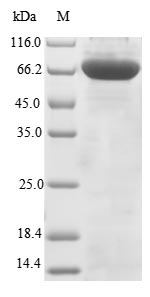Thanks for your inquiry. 1. Recombinant Human PAP-associated domain-containing protein 5(PAPD5)
CSB-YP843329HU >> Yeast
CSB-EP843329HUa2 >> E.coli
CSB-BP843329HU >> Baculovirus
CSB-MP843329HU >> Mammalian cell
Expression sequence:1-572aa; Full length of the protein
Tag Information:EP is N-terminal 6xHis-SUMO-tagged;Other possible tags for other systems are N-terminal 6xHis-tagged
Sequence:
MYRSGERLLGSHALPAEQRDFLPLETTNNNNNHHQPGAWARRAGSSASSPPSASSSPHPSAAVPAADPADSASGSSNKRKRDNKASGGRAAGGGRADGGGVVYSGTPWKRRNYNQGVVGLHEEISDFYEYMSPRPEEEKMRMEVVNRIESVIKELWPSADVQIFGSFKTGLYLPTSDIDLVVFGKWENLPLWTLEEALRKHKVADEDSVKVLDKATVPIIKLTDSFTEVKVDISFNVQNGVRAADLIKDFTKKYPVLPYLVLVLKQFLLQRDLNEVFTGGIGSYSLFLMAVSFLQLHPREDACIPNTNYGVLLIEFFELYGRHFNYLKTGIRIKDGGSYVAKDEVQKNMLDGYRPSMLYIEDPLQPGNDVGRSSYGAMQVKQAFDYAYVVLSHAVSPIAKYYPNNETESILGRIIRVTDEVATYRDWISKQWGLKNRPEPSCNGPVSSSSATQSSSSDVDSDATPCKTPKQLLCRPSTGNRVGSQDVSLESSQAVGKMQSTQTTNTSNSTNKSQHGSARLFRSSSKGFQGTTQTSHGSLMTNKQHQGKSNNQYYHGKKRKHKRDAPLSDLCR
1)As for PAPD5, the difference in the delivery time between EP and MP is that EP is a protein that has been developed and shipped before. Therefore, the conditions are all known.
In general, the EP protein expression products are lack of modification (such as glycosylation, alkylation, phosphorylation, specific protein hydrolysis processing, etc.), and the formation of disulfide bonds and wrong folding leads to the formation of inclusion bodies easily.
Generally, the protein expressed by MP has effective protein folding, which is secreted and expressed. It has all kinds of post-translational modifications, including complex n-type glycosylation and accurate o-type glycosylation. Expression products in molecular structure, physical and chemical properties and biological functions
It is most closely related to the natural higher biological protein molecules. The protein itself contains some modifications, such as phosphorylation, which generally affect the function of the protein. So MP is closer to the natural form.
2)We have not conducted active detection of this protein, nor have we received any feedback from customers. We express the full length of the protein, purified under mild conditions, and in theory the EP protein we express will also be active.
2. The site was later removed, discontinued, and the full-length protein only attempted to provide CF expression. Product details are as follows:
Recombinant Human DNA polymerase sigma(PAPD7)
CSB-CF733396HU
Expression sequence: 1-542aa ;Full Length of Isoform 2
Tag Information: N-terminal 10xHis-tagged or N-terminal 6xHis-SUMO-tagged
Sequence:
MSPCPEEAAMRREVVKRIETVVKDLWPTADVQIFGSFSTGLYLPTSDIDLVVFGKWERPPLQLLEQALRKHNVAEPCSIKVLDKATVPIIKLTDQETEVKVDISFNMETGVRAAEFIKNYMKKYSLLPYLILVLKQFLLQRDLNEVFTGGISSYSLILMAISFLQLHPRIDARRADENLGMLLVEFFELYGRNFNYLKTGIRIKEGGAYIAKEEIMKAMTSGYRPSMLCIEDPLLPGNDVGRSSYGAMQVKQVFDYAYIVLSHAVSPLARSYPNRDAESTLGRIIKVTQEVIDYRRWIKEKWGSKAHPSPGMDSRIKIKERIATCNGEQTQNREPESPYGQRLTLSLSSPQLLSSGSSASSVSSLSGSDVDSDTPPCTTPSVYQFSLQAPAPLMAGLPTALPMPSGKPQPTTSRTLIMTTNNQTRFTIPPPTLGVAPVPCRQAGVEGTASLKAVHHMSSPAIPSASPNPLSSPHLYHKQHNGMKLSMKGSHGHTQGGGYSSVGSGGVRPPVGNRGHHQYNRTGWRRKKHTHTRDSLPVSLSR
Supplementary information on PAPD5 activity:
2)https://www.ncbi.nlm.nih.gov/pmc/articles/PMC3162338/ In this paper, the recombinant PAPD5 expressed in mammalian cells and bacteria is active without protein cofactor;
we analyzed the in vitro properties of recombinant PAPD5 expressed in mammalian cells as well as in bacteria. Our results show that PAPD5 catalyzes the polyadenylation of different types of RNA substrates in vitro.
Interestingly, PAPD5 is active without a protein cofactor




